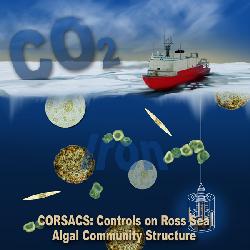Project: Controls of Ross Sea Algal Community Structure
Description
Project summary
The Controls of Ross Sea Algal Community Structure (CORSACS) project was funded by the NSF Office of Polar Programs as "Collaborative Research: Interactive Effects of Iron, Light and Carbon Dioxide on Phytoplankton Community Dynamics in the Ross Sea". Two cruises were completed in 2006 to investigate the interactions between the primary productivity of the Ross Sea and pCO2, iron and other trace elements. Data sets of carbon, nutrient, metal, and biological measurements will be reported.
The main objective in the proposed research was to investigate the relative importance and potential interactive effects of iron, light and CO2 levels in structuring algal assemblages and growth rates in the Ross Sea. The investigators hypothesized that the interaction of these three variables largely determines the bottom-up control on these two dominant Southern Ocean phytoplankton taxa. While grazing and other loss processes are important variables in determining the relative dominance of these two taxa, the CORSACS research project was designed to focus on the bottom-up control mechanisms. It is important to understand such environmentally-driven taxonomic shifts in primary production, since they are expected to impact the fixation and export of carbon and nutrients, and the production of DMS, thus potentially providing both positive and negative feedbacks on climate.
The CORSACS investigators considered a range of ambient iron, light and pCO2 levels that span those typically observed in the Ross Sea during the growing season. That is, dissolved iron ranging from ~0.1 nM (low iron) to greater than 1 nM (high iron) (Fitzwater et al. 2000; Sedwick et al. 2000); mean irradiance (resulting from vertical mixing/self shading) ranging from less than 10% Io (low light) to greater than 40% (high light) (Arrigo et al., 1998, 1999), possibly adjusted based on field observations during the CORSACS cruises; and pCO2 ranging (Sweeney et al. 2001) from ~150 ppm (low CO2) to the probable higher levels of pCO2 - 750 ppm as a conservative estimate - that are likely to be attained later this century due to anthropogenic perturbation of the global carbon cycle (IPCC, 2001).
From the information previously available from both field observations and experiments, the investigators formulated the following specific hypotheses regarding the interactive role of iron, light and CO2 in regulating algal composition in the Ross Sea: diatoms bloom in the southern Ross Sea only under optimum conditions of high iron, light and pCO2; colonial Phaeocystis dominate under conditions of high iron with either (or both) low light or low pCO2; and solitary Phaeocystis are predominant under conditions of low iron with either (or both) low light or low pCO2.
References:
Fitzwater, S.E., K.S. Johnson, R.M. Gordon, K.H. Coale, and W.O. Smith, Jr. (2000). Trace metal concentrations in the Ross Sea and their relationship with nutrients and growth. Deep-Sea Research II, 47: 3159-3179.
Martin JH, Gordon RM, Fitzwater SE. Iron in Antarctic waters. Nature 1990 ;345(6271):156-158. Martin JH. 1990. Glacial-interglacial CO2 change: The iron hypothesis. Paleoceanography 5(1):1-13
P. N. Sedwick, G. R. DiTullio, and D. J. Mackey, Iron and manganese in the Ross Sea, Antarctica: Seasonal iron limitation in Antarctic shelf waters, Journal of Geophysical Research, 105 (C5), 11,321-11,336, 2000.
Sweeney, C. K. Arrigo, and G. van Gijken (2001). Prediction of seasonal changes in surface pCO2 in the Ross Sea, Antarctica using ocean color satellite data. 2001 Annual AGU meeting, San Fransisco, CA Dec. 10-15.
IPCC, 2001: Climate Change 2001: Synthesis Report. A Contribution of Working Groups I, II, and III to the Third Assessment Report of theIntegovernmental Panel on Climate Change [Watson, R.T. and the Core Writing Team (eds.)]. Cambridge University Press, Cambridge,United Kingdom, and New York, NY, USA, 398 pp.
Publications
Saito, M. A., Goepfert, T. J., Noble, A. E., Bertrand, E. M., Sedwick, P. N., and DiTullio, G. R.: A seasonal study of dissolved cobalt in the Ross Sea, Antarctica: micronutrient behavior, absence of scavenging, and relationships with Zn, Cd, and P, Biogeosciences, 7, 4059-4082, doi:10.5194/bg-7-4059-2010, 2010 (http://www.biogeosciences.net/7/4059/2010/bg-7-4059-2010.html)
Bertrand EM, Saito MA, Lee PA, Dunbar RB, Sedwick PN and DiTullio GR (2011) Iron limitation of a springtime bacterial and phytoplankton community in the Ross Sea: implications for vitamin B12 nutrition. Front. Microbio. 2:160. doi: 10.3389/fmicb.2011.00160 (http://www.frontiersin.org/Aquatic_Microbiology/10.3389/fmicb.2011.00160/abstract)

People
Lead Principal Investigator: Giacomo DiTullio
College of Charleston (CofC)
Co-Principal Investigator: Andrew R. Bowie
University of Tasmania (UTAS)
Co-Principal Investigator: Robert B. Dunbar
Stanford University
Co-Principal Investigator: David A. Hutchins
University of Delaware
Co-Principal Investigator: Mak A. Saito
Woods Hole Oceanographic Institution (WHOI)
Co-Principal Investigator: Peter N. Sedwick
Bermuda Biological Station for Research (BBSR)
Co-Principal Investigator: Walker O. Smith
Virginia Institute of Marine Science (VIMS)
Co-Principal Investigator: Phillippe Tortell
University of British Columbia (UBC-EOS)
Programs
Ocean Carbon and Biogeochemistry [OCB]
